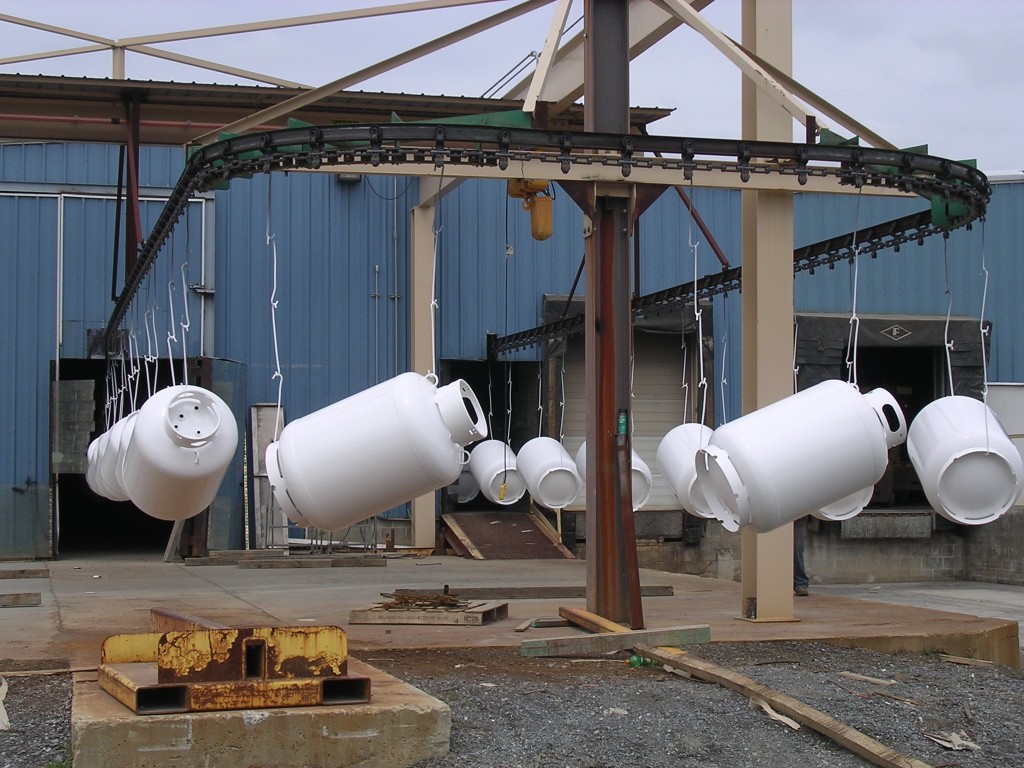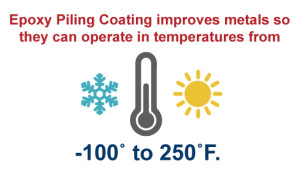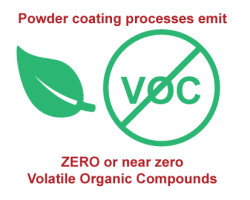Painting can be a pain. If everything isn’t accomplished perfectly there can be defects left, which can compromise the end result and cause corrosion and rust. This leaves you with a substandard finish. So it’s not terribly surprising that along the way, someone developed a much more efficient and reliable way of coating metal for protection against the elements.
We call this process powder coating. There are epoxy powders, polyester powders, and hybrid powders. In other words, there are a great many options when it comes to powder coating.
But knowing those options is only helpful if you have a solid understanding of powder coating. Essentially, powder coating is a way to “dry paint” or dry “coat” a large surface area. This is usually done for aesthetic, protective or functional purposes, or some combination of the three.
Contact a Powder Coating Expert »
 About Powder Coating
About Powder Coating
In its most basic form, powder coating is a cleaner, more durable solution to what is sometimes accomplished using liquid or aerosol-based solutions. In a way, it’s a dry spray paint that is finely ground and then evenly sprayed onto a surface. It’s then held in place by the power of static electricity while it bonds with the material.
The process has actually been around for fifty years, and it’s found in many common products and materials. For example, streetlights are often textured and pigmented using powder coatings because it’s important for them to be bright and highly visible. The beauty of this particular method is that there are many controllable elements, such as color, texture, and finish, all of which can be formulated to meet your desired specifications.
What is Powder Coating?
In comparison, liquid paint is generally composed of two separate parts: a binder and filler. The reason that paint stays liquid in a can is because of something called a solvent. This chemical separates the binder and filler.
When the paint is exposed to air, the solvent essentially evaporates and the paint dries (and binds). The end result is a piece of equipment protected from the elements, such as a light pole that’s an easy-to-see yellow or a fire engine that’s a traditional shade of red.
But liquid paint has some distinct disadvantages. There is limited control of the finish and, perhaps more unsettling, there are deep environmental concerns. Liquid paints require solvents. And while solvents evaporating during a painting project on a small scale isn’t an enormous problem, solvent use and evaporation on an industrial scale is an environmental concern.
On the opposite side of the spectrum are powder coats. Because they’re dry, they don’t require a solvent of any kind. Rather, powder coats are composed of a specially formulated mixture of dry ingredients, which have been ground down to a fine powder.
This powder is then distributed onto the targeted and prepared surface. A specially calibrated static electric charge is used to evenly apply the powder coat to the surface initially, but then heat is used to cure that coat into a layer of “skin” on top of the surface. This skin is usually quite strong and durable, and able to withstand the elements over time.
 Common Uses for Powder Coating
Common Uses for Powder Coating
Powder coating is most often used for industrial purposes, particularly for metals. You may also see powder coating used on aluminum or galvanized steel.
Metals are a popular surface because the metal interacts favorably with the electrostatic charges used to disperse the powder coating and because they hold up to the curing process quite well.
The Powder Coat Process
How is Powder Coating Applied?
No matter what material is being considered for powder coating, the process usually begins with measurements. These measurements help ensure that powder coating contractors have ample material to get the job done.
Knowing the surface area involved ensures that enough materials are ordered, and it also helps calculate the eventual curing time. The size of materials that can be coated generally depends on the space made available by individual proprietors. Powder coating, after all, requires a closed system to complete the process.
At Lane Coatings, we can accommodate parts up to 2 feet wide by 7 feet tall, and 84 feet long for polyester and 3 feet wide by 9 feet high and 110 feet long for green epoxy. We can also accommodate a maximum part weight of up to 20 tons. Lane Coatings can also receive shipping deliveries by truck or by rail.
Step 1: Preparation
Surfaces must be cleaned and protected. In other words, most powder coat providers will prep the surface to ensure smooth adhesion by utilizing sanding or a brush blast. It’s also necessary to protect any parts that you don’t want to treat, just as you would when painting a more traditional surface.
This is a little more complicated with something like powder coating, as the static charge can be quite strong, but that’s why proper preparation is key. Sometimes, depending on the end result desired, there is also a pre-treatment involved, in which the surface is given a primer coat to achieve a specific result.
Step 2: Coating

The second main step in the process is the coating itself. During this process, the surface to be coated is grounded. Again, this is one of the reasons why metal objects are a popular choice, but it’s worth mentioning again that they are not the only choice. The powder itself is applied using an electrostatic gun (sometimes called a corona gun), which essentially shoots electrically charged particles of the dry powder at the grounded surface. The electrical connection means that those particles are attracted to the surface and remain in place until the curing process begins.
Step 3: Curing
During the curing phase, the coating is exposed to high temperatures rapidly and this hardens the powder coat in place. Sometimes during an advanced powder coating procedure, a surface can be “pre-heated” to bolster the curing process. Once the curing has melted the powder, the surface is then quickly cooled, hardening the materials in place. As mentioned above, the curing process makes powder coating particularly durable and chip resistant.
Powder Coating Options
While “powder coating” is often referred to as a single procedure type, one of the hallmarks of this technique is its versatility. Consumers enjoy a wide variety of options for the final finish. Options depend on the type of surface coated, as well as the desired final result. Some powder coating options include the following:
- Epoxy Piling Coating. This is often used in industrial piping to protect from corrosion. It is more durable and can improve metals so they can operate in temperatures from -100° to 230°F. This is possible, in part, due to the special application method of the epoxy coating, during which the surface is pre-heated before the coating and curing takes place. This advanced powder coating is fusion bonded.

- Polyester Powder. This is a more standard, functional powder coating, but because of the quick finishing, polyester powder is excellent for high volume jobs. This is particularly true at Lane, where our access to rail and shipping lines means we can accommodate a high volume of materials.
- Color. When it comes to powder coating materials, many clients desire a particular color. Lane can typically meet most color demands. RAL and Federal Color standards are typically used to match special color requirements.
- Finish. In addition to having a particular color in mind, many clients also have a particular finish in mind, whether it’s glossy, flat or somewhere in between. This is another area where powder coating can easily offer a wide variety of options and easily incorporate them into the final result. Various textured finishes are also available.
Powder Coating Benefits
The benefits of powder coating can generally be divided into two categories: environmental and practical.
Due to its dry nature, powder coatings do not have to incorporate the solvents popular in liquid paint. As a result, the powder coating process is much more environmentally-friendly than other protective coatings. To some, this will be the paramount consideration.

To others, the benefit to the environment will be slightly more abstract. However, even these environmental benefits translate into savings for consumers, as powder coaters do not have to grapple with more onerous and strict government regulation (and the costs associated with them).
Powder coating processes emit zero or near zero VOCs, or volatile organic compounds.
On the more practical side of things, powder coating can also offer other benefits over liquid options. Edge protection is increased, rather than decreased as might be the case in liquid options.
Additionally, it can be very difficult to tell the difference between vertically coated and horizontally coated surfaces, which can be advantageous in many conditions. But perhaps most important is a simple fact that, generally, powder coating can make your materials last longer and look better.
Appearance and longevity are particularly crucial powder coating benefits when one considers the materials being chosen for powder coating. Whether it’s guide rails, fences, gates, piling, or a variety of other metal objects, it can be coated. Specifically, if you want something to last for a long time despite its constant exposure to the elements, opt for powder coating.
The Value of Powder Coating
The long-lasting protection powder coating offers is one of its core values. The lifespan of products can be increased by years with a simple powder coating. Powder-coated products resist chipping, resist the elements and help maintain a smooth, clean appearance.
Any piece of industrial machinery is a huge investment, so it’s imperative to protect that investment for as long as possible in order to maximize the benefits and revenue generated.
The Power of Powder
With all of these benefits, it’s not surprising that powder coating is a consistently popular option. Although it’s a process that is fifty years old, powder coaters have been innovating over the decades. More materials are eligible for powder coating now than ever before. This means that more products are powder coated and lasting longer because of it.
When it comes to the combination of aesthetics and durability, it’s tough to beat powder coating. Contact Lane Coatings for More Info »
Trust Lane Coatings
Lane Coatings is a trusted resource for a wide variety of powder coating projects. Whether it’s the reinforced steel that helps with road construction or the structural steel or aluminum that compose an entry gate system, Lane Coatings offers industrial powder coating services that will give you the finish you want. We will help you protect your investments while maintaining your environmental responsibility.
Lane Coatings is positioned to help with large, industrial projects that require substantial time and space. This is perfect for construction projects or equipment, as well as industrial implements and installations.
If you’re looking to protect your investment for the long term, powder coating is a great way to accomplish that goal – and ensure your surface looks great at the same time. And if you’re looking into a high-quality powder coating, there’s no better place to start than Lane Coatings; contact us for a quote today.

